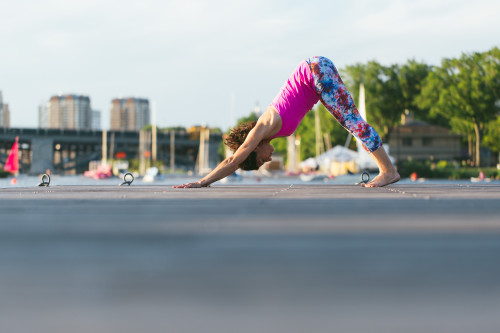
I had a private client visit me once and it was our first meeting. He was a tech entrepreneur and was very stressed. He was coming to yoga because he knew it would be a good stress release. He also spent an extraordinary amount of time on the phone and on the computer (although these days, don’t we all). In our first meeting, I had him start in Anatomical Position:

What you’ll notice about this position, at least with respect to the head, is that it’s directly over the shoulders. The head doesn’t hang back nor does it hang forward, with the chin dropping towards the chest.
When I had this student come into this shape, his head was hanging forward over his body. This is a very common in those of us that spend a lot of time on the computer without a sense of where our head is at (and I mean that literally!). Further, he had no sense that this was the position of his head.
If you come into Anatomical Position and close your eyes, do you have a sense of how your head is positioned? Try it. Stand up tall in this exact shape above and close your eyes. Notice your body in space. Feel for the position of your head, your shoulders, your hands; feel an awareness in your core, your thighs and your feet. Do you have a sense of your body in space?
Now, open your eyes. Come into Warrior Two Pose:

Keeping your eyes straight ahead, get a sense of where your back arm is in space. Do you feel it? Can you feel if it’s at the same level as your front arm? What about your back foot? Do you have a sense of where it is? Is it pointing forward or back, turned in or out? Is the outer edge pressing down or are you sunken into your inner arch?
The skill of knowing where your limbs are in space, without using your gaze is called “proprioception.” Â In humans, it’s a sense you have via receptors or “proprioceptors,” as they’re called, that live in skeletal muscles, tendons and joints. Imagine if you didn’t have a sense of yourself in space, which is also referred to as a “kinesthetic sense.” You’d be tripping all the time! But our body, in its infinite wisdom, has these receptors that protect us from falling as we walk. It also helps keep us steady when we take on any kind of movement practice, like yoga, running, dance, or anything that has us moving.
Now, back to my student with the head hanging over the front of his body. Does it mean he’s lost the proprioceptors in his neck? No, of course not. What is does mean is that posturally, because he’s in the same hunched over shape most of the day, certain muscles like the pectoralis minor, have gotten really short from working all the time. That, plus the weight of his head has dragged his chin forward into a “new normal” for his standing posture. And, coupled with that, he’s stressed, busy and so focused on his work that his “inner sense” has lost its way.
Which brings me to the title of this blog post:
Your Inner Sense is Your Best Defense
You probably have a better idea now as to what that means then when you just started reading this post. The idea is that the more we can hone our proprioceptors, the more we can counteract the negative affects of stress and poor postural positioning on the body. So, developing our kinesthetic sense gives us protection in the long term. Have you ever seen an older person running hunched over? They’ve run for many years without stretching. Their hip flexors have become so tight but without a sense of even just the basics of Anatomical Position, they’ve created a new normal for their bodies. And, without a good sense of proprioception, they’re destined to just continue to hunch and tighten their hips more as they run…. ALL at the detriment to their running! (Can you imagine how much harder it is to take a full breath in running when you’re hunched over all the time?)
Yoga is a great tool to develop our inner sense but only if it’s taught in a way that brings into the practice the basics of anatomy. Otherwise, we’ll be on the mat just moving through the same movements in the same way as we do all day (hunching over the front leg in Triangle, for instance). So, your best defense to avoiding the same old traps in class is to either study anatomy or practice with a teacher that brings the basics of anatomy into class. It doesn’t take complicated postures; in fact, the less complex, the better.
Protecting our bodies starts and ends with us. There is always time to make a change in a positive direction. Your inner sense is your best defense.

Very well stated
Thanks Jay! Glad you found it interesting. Karen